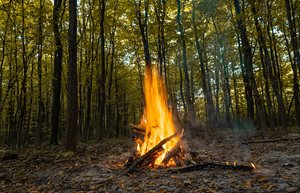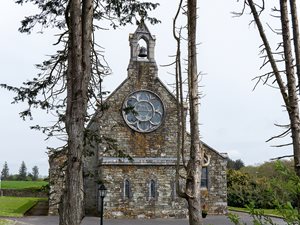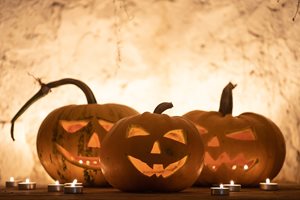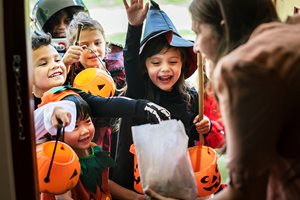Happy spooky season! This year it's especially spooky because in 2023 October has its very own Friday the 13th! Halloween is among the oldest traditions in the world and has evolved from ancient rituals and practices to today’s version as we know it.
Origins
Halloween originated some 2,000 years ago, from the ancient Celtic festival of Samhain. Meaning “summer's end”, the festival marked the close of the harvest season. The Celts celebrated their new year on November 1st and believed on the night before the new year, the veil between the worlds of the living and the dead was thinnest.
They welcomed the return of departed loved ones by setting out foods for their arrival. However, other kinds of spirits could also appear, including elves, fairies, or even the spirits of someone you may have wronged. To deceive the spirits, people would cover their faces with ash, later evolving to wearing masks, this became known as “guising”. A living person could reveal themselves to the spirit of a loved one and otherwise remain safe from the unwanted attention of darker forces.
To commemorate the event, the Celtic people often built large bonfires, wore costumes, and attempted to tell each other’s fortunes.
Roman Influence
By 43 A.D., the Roman Empire had conquered the majority of Celtic territory and combined their Autumn festivals with the traditional Samhain celebration. Their October festivity - Feralia, also commemorated the passing of the dead.
Christian Influence
By the 9th century, the influence of Christianity had spread into Celtic lands, where it began to blend with older Celtic rites. Several Christian popes attempted to replace holidays like Samhain with their own religious observances. By 1,000 A.D., All Souls' Day on November 2nd served as a time for the living to pray for the souls of the dead. All Saints' Day, or All Hallows, honored the saints on November 1st. That lead October 31st the traditional night of Samhain in the Celtic religion, to be called All Hallows Eve, and eventually Halloween.
into Celtic lands, where it began to blend with older Celtic rites. Several Christian popes attempted to replace holidays like Samhain with their own religious observances. By 1,000 A.D., All Souls' Day on November 2nd served as a time for the living to pray for the souls of the dead. All Saints' Day, or All Hallows, honored the saints on November 1st. That lead October 31st the traditional night of Samhain in the Celtic religion, to be called All Hallows Eve, and eventually Halloween.
English Celebrations
In England poor citizens would go “souling” on All Souls’ Day, traveling door to door to beg for food. Families would give them pastries called “soul cakes” in return for their promise to pray for the family’s dead relatives. This custom combined with the Celts practice of “guising” likely inspired the American version of dressing up in costume to go trick-or-treating.
Halloween Comes to Colonial America
The celebration of Halloween was limited in colonial New England. However, as the beliefs and customs of different European ethnic groups and the Native Americans meshed, a distinctly American version of Halloween began to emerge. The first Halloween-like festivities in America started in the southern colonies, people began to celebrate the harvest, swap ghost stories, and even tell each other's fortunes.
The rituals of Samhain arrived in the United States with the displacement of the Irish in 1845-1849, during the potato famine. The newcomers brought their own Halloween beliefs and customs to their new homes, including the jack-o'-lantern. Associated with the Irish folk tale of Stingy Jack, a clever con man who after his death was not welcome in heaven or hell. He instead roamed the earth carrying a lantern made of a turnip with a red-hot ember from hell inside to light his way. Shortly after the Irish's arrival in the United States, they traded the turnip for the pumpkin as their lantern-of-choice.
homes, including the jack-o'-lantern. Associated with the Irish folk tale of Stingy Jack, a clever con man who after his death was not welcome in heaven or hell. He instead roamed the earth carrying a lantern made of a turnip with a red-hot ember from hell inside to light his way. Shortly after the Irish's arrival in the United States, they traded the turnip for the pumpkin as their lantern-of-choice.
American Halloween
By the start of the 20th century, many communities were partaking in a more secular (and safer) set of rituals. By the 1920s and 1930s, Halloween had become a community-centered holiday, with parades and town-wide parties featuring games, seasonal treats, and fun costumes. However, with these events, Halloween vandalism and mischief grew more widespread.
Between 1930 and 1950, trick-or-treating began to grow in popularity as it was a relatively inexpensive way for an entire community to share the Halloween celebration. The hope was families could also prevent tricks being played on them by providing the neighborhood children with small treats. Thus, a new American tradition was born, and it has continued to grow.
it was a relatively inexpensive way for an entire community to share the Halloween celebration. The hope was families could also prevent tricks being played on them by providing the neighborhood children with small treats. Thus, a new American tradition was born, and it has continued to grow.
Over time, all these traditions have evolved as beliefs changed and people continued to immigrate to and from different countries. It brought together many different cultural practices regarding the Halloween season and has turned into the 21st century version we know today. Halloween is – or can be – a triumph of hope over fear, which is most likely what it also meant to the ancient Celts at Samhain thousands of years ago.
Have a fun and safe Halloween! In the spirit of keeping safe, visit our Security Center page to learn how to protect your credit, avoid fraud and scams. It's all treats and helps you avoid tricks.